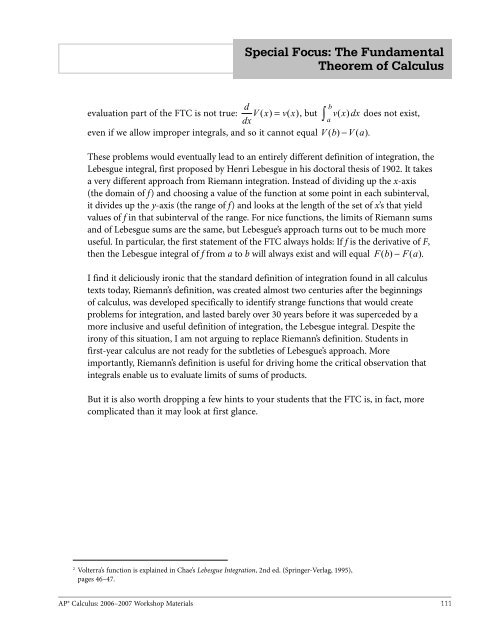AP Calculus
Calculus_SF_Theorem
Calculus_SF_Theorem
You also want an ePaper? Increase the reach of your titles
YUMPU automatically turns print PDFs into web optimized ePapers that Google loves.
Special Focus: The Fundamental<br />
Theorem of <strong>Calculus</strong><br />
d<br />
evaluation part of the FTC is not true:<br />
dx V ( x)<br />
= v( x)<br />
b<br />
, but ∫ v ( x ) dx does not exist,<br />
a<br />
even if we allow improper integrals, and so it cannot equal V ( b) − V ( a).<br />
These problems would eventually lead to an entirely different definition of integration, the<br />
Lebesgue integral, first proposed by Henri Lebesgue in his doctoral thesis of 1902. It takes<br />
a very different approach from Riemann integration. Instead of dividing up the x-axis<br />
(the domain of f) and choosing a value of the function at some point in each subinterval,<br />
it divides up the y-axis (the range of f) and looks at the length of the set of x’s that yield<br />
values of f in that subinterval of the range. For nice functions, the limits of Riemann sums<br />
and of Lebesgue sums are the same, but Lebesgue’s approach turns out to be much more<br />
useful. In particular, the first statement of the FTC always holds: If f is the derivative of F,<br />
then the Lebesgue integral of f from a to b will always exist and will equal F( b) − F( a).<br />
I find it deliciously ironic that the standard definition of integration found in all calculus<br />
texts today, Riemann’s definition, was created almost two centuries after the beginnings<br />
of calculus, was developed specifically to identify strange functions that would create<br />
problems for integration, and lasted barely over 30 years before it was superceded by a<br />
more inclusive and useful definition of integration, the Lebesgue integral. Despite the<br />
irony of this situation, I am not arguing to replace Riemann’s definition. Students in<br />
first-year calculus are not ready for the subtleties of Lebesgue’s approach. More<br />
importantly, Riemann’s definition is useful for driving home the critical observation that<br />
integrals enable us to evaluate limits of sums of products.<br />
But it is also worth dropping a few hints to your students that the FTC is, in fact, more<br />
complicated than it may look at first glance.<br />
2<br />
Volterra’s function is explained in Chae’s Lebesgue Integration, 2nd ed. (Springer-Verlag, 1995),<br />
pages 46–47.<br />
<strong>AP</strong>® <strong>Calculus</strong>: 2006–2007 Workshop Materials 111


